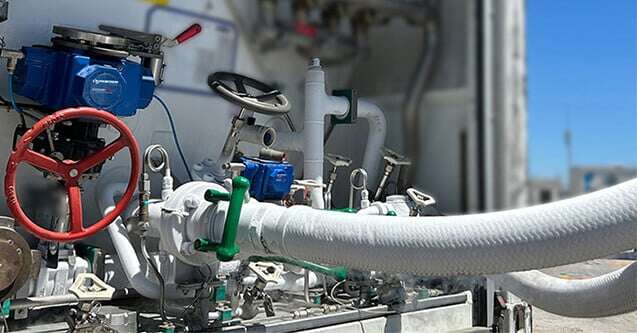An illustrative example showcases an FBV system installed within the limited space of an ISO tank for LNG, underscoring the contrast between our four-piston schematics and the conventional two-piston layout, emphasizing the compact nature of our design.
The unique Fire Block Valves (FBV) system developed by Habonim for emergency shutdown applications, is specifically designed for Liquefied natural gas (LNG) systems. As we explore the significance and advantages of FBV and Emergency Shutdown Systems (ESD), we will delve into the technical aspects of these systems, alongside the relevant standards and certifications. Additionally, we will showcase some success stories that demonstrate the effectiveness of these solutions.
FBV systems play a critical role in ESD scenarios, particularly in safely and efficiently handling liquefied gases.
Requirements and Applications
ISO tanks application
ISO tanks, built according to ISO standards, are versatile containers made of stainless steel with various protective layers, used to transport different bulk liquids by trucks, trains, or ships. The initial demand for fire block valves stemmed from their application in ISO tanks.
Another key application for fire block systems is in cryogenic transport trailers, which have varying configurations depending on the media being transported.

What is a Fire Block Valve system?
In a typical Fire Block Valve system, a shuttle valve with a spring-loaded mechanism and various activation unit options plays a crucial role. These systems can be pneumatic, manual, or dual, allowing for manual or automatic valve closure based on specific requirements and situations.
Once the valve is opened, the stop mechanism engages to secure the spring-loaded mechanism. This mechanism keeps the system open until the activating unit is released, either manually by the operator after routine media transfer, or automatically in case of a fire event.
Understanding the role of each component is essential for optimizing system performance.

At the core of our fire block system is the valve, where reliability and performance are paramount. Our continuous enhancements ensure optimal functionality and safety.
With a strong focus on engineering excellence and customer service, Habonim has established itself as a key player in FBV systems. Our HermetiX Integrity Package, present across most product lines, showcases our commitment to safety and reliability.
Building on a decade-long journey that began with HermetiX stem sealing, we have obtained certifications such as ISO 15848 and APS641 for fugitive emissions. Our focus then shifted to developing the HermetiX Fire Safe line, meeting standards like API 607 and ISO 10497, to enhance safety and reliability.

The return mechanism
In terms of Habonim’s return mechanism, based on our CompAct spring return actuator, that stands out for its quality, size, force rate, and speed. With a unique four-piston design, it offers advantages like compactness, quicker operation, and enhanced shutdown speed for emergency scenarios.
The automatic shutoff mechanism, whether through fusible plugs or links, is tailored to system size and customer preference. These mechanisms ensure timely closure in critical situations, such as fire events, showcasing our commitment to safety.
To operate the valve, we offer manual, automatic, and dual options, each designed to meet specific requirements. The declutchable gear mechanism ensures easier operation and safety, especially for high-torque valves, enhancing overall system efficiency.
In conclusion, our focus on innovation, safety, and reliability is evident in the success stories of our valve configurations. From manual valves to dual-activated systems, we continue to provide tailored solutions for various applications, ensuring consistent quality and performance.
Noteworthy is its compact design achieved by utilizing a four-piston actuator’s configuration, instead of the traditional two-piston setup. This innovative design allows for the same torque to be generated using smaller piston diameters, resulting in a more streamlined and space-efficient actuator. System designers can leverage these compact advantages in confined assemblies, optimizing space utilization.

Moreover, the swift response time of our actuators is a key feature, achieved by delivering the same torque output with smaller piston diameters. This attribute is particularly crucial for rapid shutdown applications during emergencies. The reduced air volume and stroke length of the compact pistons contribute significantly to minimizing response times compared to the traditional two-piston structure.
In critical systems, even milliseconds can hold immense significance for end-user outcomes, prompting system designers to prioritize tight shut-off times for optimal performance. The compact actuators exhibit an average speed advantage of approximately 50% over competitors, further accentuating their efficiency, especially in scenarios involving high torque cryogenic media.
This speed advantage is highlighting the superior performance of CompAct Actuators in high torque applications. Swift operation is imperative for FBV systems, ensuring safety and operational efficiency. Hence, the benefits of CompAct Actuators become more pronounced as operational demands escalate.
Even though the CompAct basic design has relatively fast action, sometimes the system requirements for short of time is even more strict than the standard CompAct Actuator speed. As you might know, Habonim is one of the very few valves manufacturers that also designed and produced its own actuator line. This fact is giving us the ability to upgrade the actuator to perform faster.
We can upgrade our actuators with strict shut-off times requirements by enhancing air evacuation techniques, which is basically limiting us in closing time. This capability allows us to increase shutdown speed by 5 to 10 times.

The automatic shutoff mechanism
For large, high-torque valves, a robust stop mechanism is utilized, while smaller valves feature automatic stop mechanisms, ensuring reliability and safety across all valve sizes.

Automatic shutdown options include fusible plugs or fusible links, which are selected based on the size of the FBV system and the specific operational requirements. Flexibility in meeting customer needs is paramount.
A fusible plug or link acts as a temperature sensor, closing the system at a designated temperature threshold.

Options for Valve operations
Valves can be opened manually, automatically, or through a dual mechanism combining manual and automatic operation. Smaller valves are usually operated manually using a simple handle, which must be removed after opening to ensure safety during emergency shutdowns. High-torque valves, typically above two inches, require a declutchable gear mechanism for easier operation while maintaining control and safety. After opening the valve, it is crucial to return the gear to a neutral position for automatic closure if needed.
The comprehensive package includes CompAct Actuator designs with four pistons offering significant advantages by simplifying maintenance and testing for both routine and emergency operations. Our systems undergo rigorous vibration tests to ensure reliability, even in challenging conditions such as rough road conditions.
The options for operating valves are versatile, diverse to different sizes and torque requirements. Whether manual, automatic, or dual operation, our systems are designed to provide efficient and reliable valve control solutions.

Whole package
Relying on the CompAct Actuator design, offers substantial advantages. By utilizing a single unit for both routine and emergency operations, we streamline maintenance and testing processes, making our system more cost-effective, compact, and efficient compared to competitors.
Additionally, our systems undergo stringent vibration tests according to USME standard 810F, ensuring reliability even in challenging conditions such as rough road surfaces.
Moreover, our products are certified within SIL-3 or SIL-2 loops, depending on the specific product, guaranteeing reliable and swift closure in the event of system malfunctions. With a wealth of experience and proven references in various industries like refineries and power stations, we also offer TPED certification for select products essential for applications involving trailers.
Our product line boasts a standard catalogue, price list, and consistent lead times, ensuring dependable quality and availability. With a range of configurations tailored to meet diverse customer needs, we provide solutions for various applications.
In addition to our successful implementations, such as the manual valve configurations with extended butt-weld connections and dual-activated valves, we welcome you to explore our website for more information, including catalogues, IOMs, and valve models. Visit our Knowledge Center for access to past blogs, webinars, and other valuable resources.
For inquiries on system performance, the typical closing time for small-scale systems up to C30 is typically less than half a second, while larger C45 and C60 systems have a typical closing time of about one second. Should you have any further questions, please visit our website and complete the contact us section, where our expert team or Regional Managers will promptly assist you. Experience the expertise and consultation services offered by Habonim for your specific application needs.
Success stories
We have successfully implemented various valve configurations, showcasing the versatility and effectiveness of our FBV systems in real-world applications.

Let's delve into the first valve configuration, consisting of three manual valves in sizes of two inches, one and a half inches, and one inch, all equipped with extended butt-weld connections. This specific setup was introduced in 2017 and has been a popular choice, with hundreds sold each year. Taking a closer look at this configuration, we see a combination of small-scale FBV valves operated manually. It's important to note that the handles are not meant to remain on the valves; they are only used during the opening process and should be removed afterwards for safety.

Moving on to the second valve configuration, we have a 3" dual-activated valve and 1" manual valve, both featuring extended butt-weld connections. This newer configuration was implemented in 2021 and has seen consistent sales. Taking a closer look at these valves, we notice the declutchable gear on the larger three-inch valve, as well as fusible plugs for non-automated activation. The stop mechanism for the larger valve is manual, while the smaller valve features an automatic stop mechanism for added efficiency.
Visit Habonim's website for more information and expert consultation on your specific application needs.
<< Consult our experts about your application >>
Based on a Webinar held on 26.06.2024









